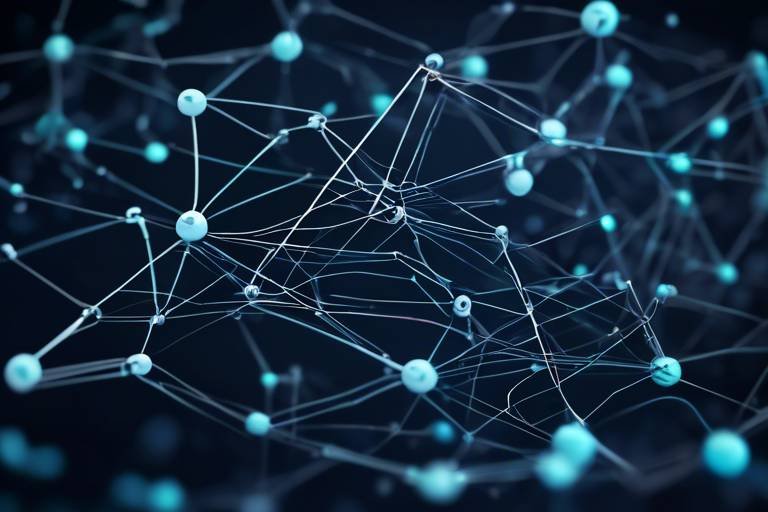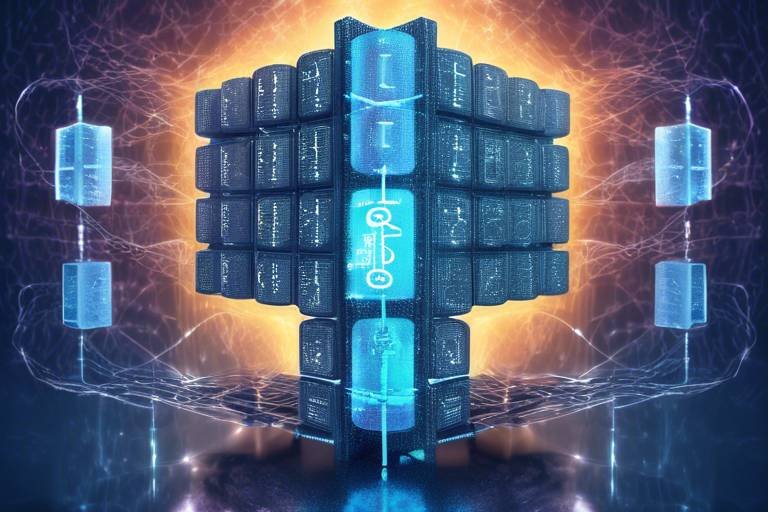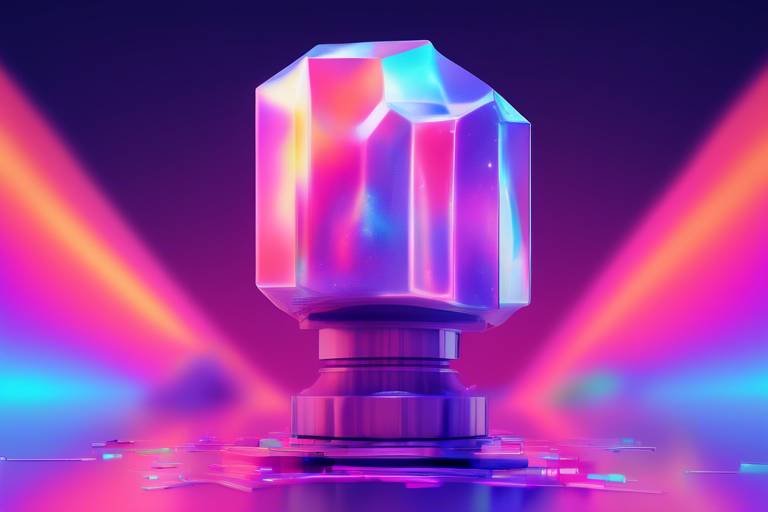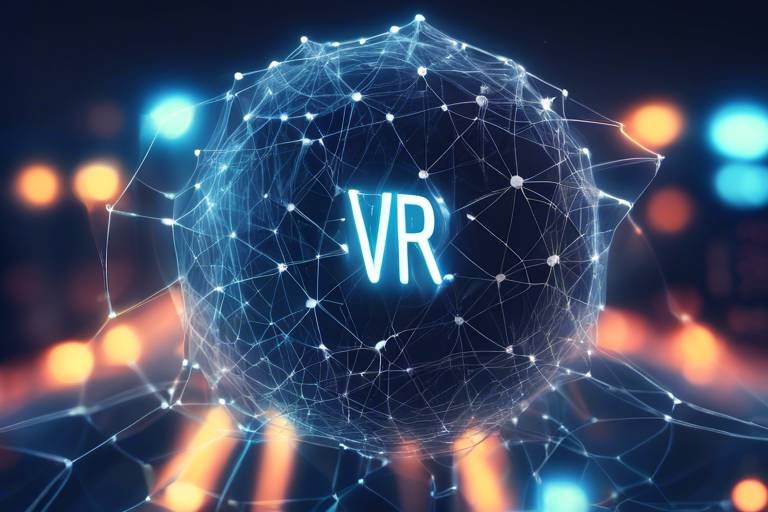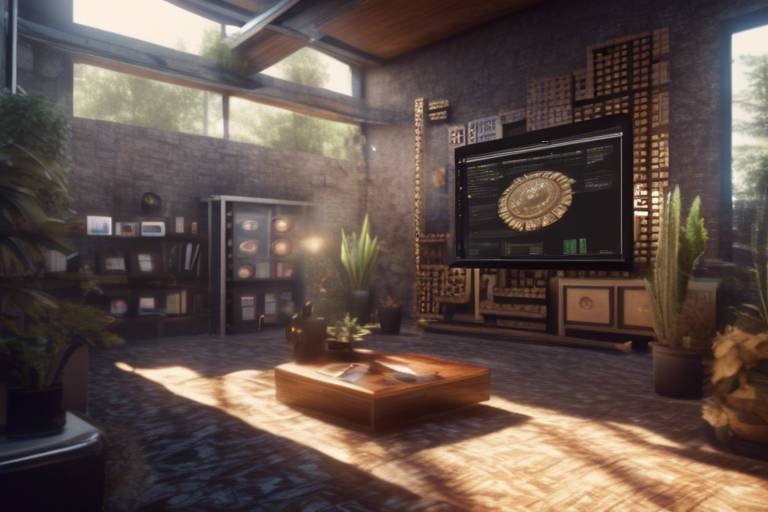The Graph - Indexing Blockchain Data
In the ever-evolving landscape of blockchain technology, data accessibility is a critical factor that can determine the success or failure of decentralized applications (dApps). Enter The Graph, a decentralized protocol that is revolutionizing the way we index and query blockchain data. Imagine trying to find a needle in a haystack; that's what it feels like to access blockchain data without an efficient indexing system. The Graph acts as a powerful search engine for blockchain, enabling developers to retrieve and utilize data in real-time without the cumbersome processes typically associated with traditional databases.
The Graph protocol is designed to facilitate seamless interactions between dApps and blockchain data, allowing developers to focus on building innovative solutions without worrying about data retrieval complexities. By offering a robust framework for indexing, The Graph empowers users to access relevant information swiftly, which is particularly crucial in industries like decentralized finance (DeFi) and non-fungible tokens (NFTs). This article will delve into the architecture of The Graph, its key components, and the transformative impact it has on the blockchain ecosystem.
One of the standout features of The Graph is its ability to index data from various blockchain networks, making it a versatile tool for developers. Whether you’re building a DeFi application that requires real-time price feeds or an NFT marketplace that needs to display transaction histories, The Graph provides the infrastructure necessary to make these tasks manageable and efficient. In essence, The Graph is not just a tool; it’s a bridge connecting the vast world of blockchain data with the applications that rely on it.
As we navigate through this article, we will uncover how The Graph operates, the significance of its components such as subgraphs and indexers, and the practical applications that highlight its utility. From enhancing user experiences to driving innovation in the blockchain space, The Graph is poised to be a game-changer in the way we interact with decentralized technologies.
- What is The Graph? - The Graph is a decentralized protocol for indexing and querying blockchain data, enabling efficient access for decentralized applications.
- How does The Graph work? - It uses a network of indexers to process subgraphs, which are specific data structures that define how to access blockchain data.
- What are subgraphs? - Subgraphs are open APIs that allow developers to define how data from a blockchain should be indexed and queried.
- Why is The Graph important for DeFi and NFTs? - It provides real-time data access, which is crucial for trading, lending, and enhancing user experiences in NFT marketplaces.

Understanding The Graph Protocol
The Graph protocol is a groundbreaking solution designed to facilitate the efficient querying of blockchain data. Imagine trying to find a needle in a haystack; that's how daunting accessing specific blockchain information can be without a structured approach. The Graph streamlines this process, allowing developers and decentralized applications (dApps) to access real-time data seamlessly. At its core, The Graph operates on a decentralized network, which means it doesn't rely on a single entity to manage data. Instead, it empowers a community of indexers, curators, and developers to work together in an ecosystem that prioritizes transparency and efficiency.
One of the most fascinating aspects of The Graph is its architecture, which is designed to be both flexible and robust. It consists of a series of components that work in harmony to ensure that data is not just accessible but also indexed in a way that makes it easy to retrieve. The protocol utilizes a unique system of subgraphs—essentially, these are open APIs that define how to access specific data from a blockchain. Think of subgraphs as specialized search engines for particular data types; they allow developers to pinpoint exactly what they need, without sifting through irrelevant information.
But how does this all come together? The Graph employs a decentralized network of indexers who are responsible for processing these subgraphs. These indexers play a critical role in the ecosystem by ensuring that data is readily available to users. They earn rewards for their work, which incentivizes them to maintain the network's efficiency and reliability. This decentralized approach not only enhances security but also democratizes access to blockchain data, making it available to anyone, anywhere.
Moreover, The Graph's architecture is designed to support a wide range of blockchain networks. Whether it's Ethereum, IPFS, or any other blockchain, The Graph provides the tools necessary to index and query data effectively. This versatility opens up a world of possibilities for developers, enabling them to create innovative applications that leverage the power of blockchain technology without being bogged down by the complexities of data management.
In summary, The Graph protocol revolutionizes how we access blockchain data. By combining a decentralized network with a structured indexing system, it ensures that developers can focus on building their applications rather than getting lost in the data maze. As we dive deeper into the various components of The Graph, it becomes clear that this protocol is not just a tool—it's a game changer in the blockchain ecosystem.

Key Components of The Graph
When diving into The Graph, it’s essential to understand the foundational elements that make this protocol tick. At its core, The Graph is composed of three critical components: subgraphs, indexers, and curators. Each of these plays a unique role in ensuring that blockchain data is not only indexed but also readily accessible for decentralized applications (dApps). Without these components working in harmony, the seamless experience that users and developers have come to expect would simply not be possible.
The first component, subgraphs, can be thought of as the building blocks of data indexing. They define how specific data from the blockchain should be structured and queried. Imagine them as a set of instructions that tell The Graph what data to look for and how to make it accessible. Developers create subgraphs tailored to their needs, allowing them to extract only the most relevant information for their applications. This customization is vital, especially considering the vastness of blockchain data, which can often feel like searching for a needle in a haystack.
Next up are the indexers. These are the diligent workers of The Graph's ecosystem. Their primary responsibility is to process the subgraphs and serve the data to users. Think of indexers as librarians in a massive library of blockchain data. They don’t just store information; they also ensure that it’s organized and easy to retrieve. Indexers earn rewards for their services, creating a financial incentive to maintain the system's efficiency and reliability. The more efficiently they process and serve data, the more they benefit, fostering a healthy ecosystem.
Finally, we have the curators. These individuals or entities play a crucial role by signaling which subgraphs are valuable and worth indexing. Curators essentially act as quality control, ensuring that only the best and most relevant subgraphs are prioritized. They stake tokens to back their chosen subgraphs, aligning their interests with the network's overall health and performance. Without curators, there would be a risk of low-quality data flooding the system, which could lead to inefficiencies and a poor user experience.
To summarize, the synergy between subgraphs, indexers, and curators is what makes The Graph a revolutionary tool in the blockchain space. Each component has its own distinct responsibilities, yet they all work together to provide a seamless data indexing and querying experience. This collaboration not only enhances the accessibility of blockchain data but also empowers developers to create innovative applications that leverage real-time information.
In the ever-evolving landscape of blockchain technology, understanding these key components is crucial for anyone looking to harness the power of The Graph. As we continue to explore its applications, it becomes clear how pivotal these elements are in shaping the future of decentralized applications.
- What is a subgraph? A subgraph is a specific set of instructions that defines how to index and query blockchain data for particular applications.
- How do indexers earn rewards? Indexers earn rewards by processing subgraphs and providing data to users efficiently.
- What role do curators play in The Graph? Curators signal which subgraphs are valuable, ensuring that only high-quality data is prioritized for indexing.
- Can anyone create a subgraph? Yes, developers can create subgraphs tailored to their specific data needs, making The Graph highly customizable.

Subgraphs Explained
When we talk about subgraphs, we're diving into one of the most vital components of The Graph protocol. Think of a subgraph as a specialized index that organizes and categorizes blockchain data, making it easier for developers to access exactly what they need without sifting through mountains of information. Just like a library has sections for different genres of books, subgraphs allow for the efficient querying of data tailored to specific applications. This is particularly important in the world of decentralized applications (dApps), where speed and accuracy can make or break user experience.
Creating a subgraph involves defining a data source, which could be a smart contract on a blockchain, and specifying the data that needs to be indexed. Developers use a GraphQL schema to outline what data they want to retrieve, much like setting up a blueprint for a house. Once the schema is defined, the subgraph can be deployed on The Graph network, where it becomes a part of the larger ecosystem. This process not only streamlines data retrieval but also ensures that the data remains up-to-date and relevant.
The importance of subgraphs cannot be overstated. They enable developers to access tailored data for their applications, which enhances performance and user satisfaction. For instance, if a developer is building a dApp focused on trading tokens, they can create a subgraph that indexes transaction histories, market prices, and user balances. This targeted approach allows for real-time updates and accurate information delivery, which is crucial in fast-paced environments like cryptocurrency trading.
Additionally, subgraphs can be shared and reused across different projects, promoting collaboration and innovation within the blockchain community. Developers can leverage existing subgraphs to build upon, rather than starting from scratch. This not only saves time but also fosters a sense of community, as teams can share insights and improvements. In this way, subgraphs act as building blocks for the decentralized web, enabling a more interconnected and efficient ecosystem.
In summary, subgraphs are the backbone of The Graph's indexing capabilities. They allow for the efficient organization and retrieval of blockchain data, empowering developers to create responsive and user-friendly applications. By simplifying the data access process, subgraphs play a crucial role in the growth and development of decentralized technologies, making blockchain data more accessible than ever before.

Creating a Subgraph
Creating a subgraph in The Graph is akin to laying the foundation for a skyscraper; it requires careful planning and execution to ensure that everything stands tall and functions smoothly. The process begins with defining the data sources you want to index. These sources can range from Ethereum smart contracts to other blockchain networks, depending on your project's needs. It's essential to have a clear understanding of the data structure and relationships to create an efficient and effective subgraph.
Once you've identified your data sources, the next step is to write the subgraph manifest, which is a JSON file that outlines how to fetch and process the data. This manifest serves as a blueprint, detailing the data entities, their relationships, and the events that trigger data updates. By specifying these elements, you enable The Graph to know precisely what to look for and how to interpret it. Think of this manifest as the recipe that guides the chef in preparing a delicious dish; without it, the final product may not turn out as expected.
After crafting the manifest, you will need to implement the mapping functions. These functions are written in AssemblyScript and are responsible for transforming the raw data from the blockchain into a format that can be easily queried. Mapping functions act like translators, converting complex blockchain data into user-friendly formats. This step is crucial because it ensures that the data is not only accessible but also relevant and useful to developers building decentralized applications.
Now, you might wonder how to deploy your subgraph once everything is in place. The deployment process involves using The Graph's CLI (Command Line Interface) to push your subgraph to the network. This is where your creation comes to life, and it becomes available for indexing. After deployment, it’s wise to monitor its performance and make necessary adjustments. Just like a gardener tends to their plants, you should regularly check on your subgraph to ensure it’s thriving and providing accurate data.
In summary, creating a subgraph involves:
- Defining data sources: Identify which blockchain data you want to index.
- Writing the subgraph manifest: Create a JSON file that outlines the data structure and relationships.
- Implementing mapping functions: Write AssemblyScript functions to transform raw blockchain data.
- Deploying the subgraph: Use The Graph's CLI to make your subgraph live.
- Monitoring and optimizing: Regularly check the performance and make adjustments as needed.
By following these steps, developers can create tailored subgraphs that meet their specific data indexing needs, ultimately enhancing the functionality of their decentralized applications. In the ever-evolving landscape of blockchain technology, having the ability to efficiently create and manage subgraphs is a game changer, enabling developers to focus on innovation while The Graph handles the heavy lifting of data indexing.

Subgraph Deployment and Management
Once you've crafted a subgraph, the journey doesn't just stop there; in fact, it’s just the beginning! Managing the deployment of your subgraph is a crucial step that ensures it operates smoothly and efficiently. Think of it like tending to a garden: you plant the seeds (create the subgraph), but you also need to regularly water and prune it (manage its deployment) to see it flourish.
To effectively manage your subgraph, you should consider several key practices. First and foremost, monitoring is essential. You can utilize various tools and dashboards that The Graph provides to keep an eye on your subgraph's performance. This allows you to identify any potential issues before they become significant problems. For instance, if you notice a sudden drop in query responses, it could indicate a need for optimization or a potential bug that requires your attention.
Next, updating your subgraph is vital as the blockchain ecosystem is constantly evolving. New features, data sources, or even changes in user demand can necessitate adjustments to your subgraph. Regularly revisiting the structure and logic of your subgraph ensures that it remains relevant and efficient. You might find that adding new fields or adjusting the indexing logic can significantly enhance performance.
Another important aspect is optimizing your subgraph for performance. This involves fine-tuning your queries and ensuring that they are as efficient as possible. For example, minimizing the number of unnecessary fields retrieved can significantly reduce the load on your indexers and speed up response times. You might also want to analyze the query patterns and adjust your subgraph accordingly to cater to the most common requests.
In addition to these practices, it's beneficial to maintain clear documentation of your subgraph. This not only helps you keep track of changes but also aids other developers who might interact with your subgraph later. A well-documented subgraph can be a lifesaver when troubleshooting issues or when you need to onboard new team members.
Finally, engaging with the community can provide invaluable insights. The Graph has a vibrant ecosystem of developers and users who often share their experiences and solutions to common problems. Participating in forums or Discord channels can help you stay updated on best practices and new features that can enhance your subgraph's performance.
In summary, deploying and managing a subgraph is an ongoing process that requires attention and adaptability. By monitoring performance, updating regularly, optimizing queries, documenting thoroughly, and engaging with the community, you can ensure that your subgraph remains a powerful tool in the ever-evolving blockchain landscape.
- What is a subgraph? A subgraph is a specific indexing structure that allows developers to query blockchain data efficiently.
- How do I create a subgraph? You can create a subgraph by defining data sources and deploying it on The Graph network.
- Why is monitoring important? Monitoring helps identify performance issues early, allowing for timely optimizations.
- Can I update my subgraph after deployment? Yes, regular updates are essential to adapt to changes in the blockchain ecosystem.
- How can I optimize my subgraph? You can optimize by fine-tuning queries and minimizing unnecessary data retrieval.

The Role of Indexers
Indexers are the backbone of The Graph ecosystem, serving a crucial function in the processing and retrieval of blockchain data. Imagine them as the librarians of a vast library filled with endless books of blockchain transactions and smart contracts. Just as a librarian organizes books to make them easily accessible, indexers organize and index the data so that decentralized applications (dApps) can query it efficiently. Without indexers, the potential of blockchain data would remain untapped, leading to delays and inefficiencies in accessing real-time information.
When a developer creates a subgraph, they define the specific data they want to index. This is where indexers come into play. They take these subgraphs and process them, ensuring that the data is readily available for users who need it. The role of indexers can be broken down into several key responsibilities:
- Data Processing: Indexers validate and process the blockchain data that corresponds to the subgraphs, ensuring accuracy and reliability.
- Query Handling: They respond to queries from dApps, delivering the requested data quickly and efficiently.
- Network Maintenance: Indexers help maintain the overall health of The Graph network by ensuring that data is up-to-date and accessible.
Incentives play a significant role in motivating indexers to perform their duties effectively. They earn rewards in the form of GRT tokens (the native token of The Graph) for their contributions. This creates a competitive environment where indexers strive to provide the best service possible, leading to faster query responses and more reliable data. The more efficient an indexer is, the more queries they can handle, which translates into higher rewards. This incentive structure not only benefits the indexers but also enhances the overall performance of the network.
Moreover, indexers must stay updated on the latest changes in the blockchain landscape. As new protocols and updates are introduced, indexers need to adapt their indexing strategies to accommodate these changes. This dynamic nature of the role ensures that The Graph remains relevant and efficient in serving the needs of its users.
In summary, indexers are pivotal to the functionality of The Graph. They bridge the gap between complex blockchain data and user-friendly access, enabling developers to build innovative dApps that can query data seamlessly. As the demand for decentralized applications continues to grow, the role of indexers will only become more critical, reinforcing their position as essential players in the blockchain ecosystem.
Q1: What is The Graph?
A1: The Graph is a decentralized protocol that allows developers to index and query blockchain data efficiently. It acts as a bridge between blockchain networks and decentralized applications.
Q2: How do indexers earn rewards?
A2: Indexers earn rewards in GRT tokens for processing subgraphs and responding to queries. The more efficient they are, the more queries they can handle, leading to higher rewards.
Q3: Can anyone become an indexer?
A3: Yes, anyone can become an indexer by setting up the necessary infrastructure and participating in the network. However, it requires technical knowledge and resources to maintain efficient operations.
Q4: Why are subgraphs important?
A4: Subgraphs are essential because they define the specific data sets that indexers will process, allowing developers to tailor their data indexing needs for their applications.

Use Cases of The Graph
The Graph has emerged as a game-changer in the blockchain space, offering a myriad of applications across various sectors. Its ability to index and query blockchain data efficiently makes it an indispensable tool for developers and businesses alike. From decentralized finance (DeFi) to non-fungible tokens (NFTs), The Graph serves as the backbone for many innovative projects, enabling them to access real-time data seamlessly. Imagine trying to navigate a vast ocean without a map; The Graph provides that map, guiding users through the complexities of blockchain data.
One of the most prominent use cases of The Graph is in the realm of Decentralized Finance (DeFi). DeFi applications require reliable and up-to-date information to facilitate trading, lending, and yield farming. With The Graph, developers can create subgraphs that index vital data such as token prices, liquidity pools, and transaction histories. This capability not only enhances the user experience but also ensures that applications can respond swiftly to market changes. For instance, consider a trading platform that needs to display live price feeds; The Graph allows it to pull this data in real-time, ensuring that users are always informed and can make timely decisions.
In addition to DeFi, The Graph plays a crucial role in the world of Non-Fungible Tokens (NFTs). NFTs are unique digital assets that require specific metadata to be indexed effectively. The Graph simplifies this process by allowing NFT marketplaces to access essential information such as ownership history, transaction records, and associated media. This not only enhances the user experience but also builds trust within the community as buyers can verify the authenticity and provenance of their NFTs. For example, an NFT platform leveraging The Graph can quickly retrieve and display an artwork's entire history, making it easier for potential buyers to make informed decisions.
Moreover, The Graph's versatility extends beyond just DeFi and NFTs. It is also being utilized in various other sectors, including gaming, supply chain management, and social media. By providing a robust framework for data indexing and querying, The Graph enables developers to create applications that are not only efficient but also scalable. As more projects adopt this technology, the potential use cases continue to expand, paving the way for a more interconnected and data-driven blockchain ecosystem.
In summary, The Graph is revolutionizing how developers and businesses access blockchain data. Its applications in DeFi, NFTs, and beyond showcase its versatility and importance in the growing decentralized landscape. As we move forward, it’s exciting to think about the new possibilities that will emerge as more projects leverage The Graph's capabilities to enhance their offerings.
- What is The Graph? - The Graph is a decentralized protocol designed for indexing and querying blockchain data, making it easier for developers to access real-time information.
- How does The Graph improve DeFi applications? - It allows DeFi applications to access reliable and up-to-date data, which is crucial for trading, lending, and yield farming.
- Can The Graph be used for NFTs? - Yes, The Graph supports NFT marketplaces by indexing metadata and transaction histories, enhancing user experience and trust.
- What are subgraphs? - Subgraphs are specific data structures created within The Graph that index particular blockchain data, enabling tailored data access for applications.

The Graph in DeFi Applications
Decentralized finance, or DeFi, is like a wild west of financial services, where traditional banking norms are tossed out the window, and blockchain technology takes the reins. In this exhilarating landscape, real-time data is the lifeblood of every transaction, trade, and investment. This is where The Graph steps in, acting as the essential backbone that enables DeFi applications to function smoothly and efficiently. Imagine trying to navigate a bustling city without a map; that’s what it’s like for DeFi developers without The Graph. They need a reliable source of data to make informed decisions, and The Graph provides just that.
One of the most impressive aspects of The Graph is its ability to index vast amounts of blockchain data in a way that’s not only efficient but also incredibly user-friendly. By utilizing subgraphs, developers can create specific data queries tailored to their applications. This means that whether you’re trading cryptocurrencies, lending assets, or engaging in yield farming, you can access the exact information you need without sifting through mountains of irrelevant data. The Graph essentially acts as a sophisticated search engine for the blockchain, allowing users to retrieve data quickly and accurately.
Moreover, the role of The Graph in DeFi applications extends beyond mere data retrieval. It enhances the overall user experience by providing real-time analytics and insights, which are crucial for making timely decisions. For instance, in the world of yield farming, where users stake their assets to earn rewards, having access to real-time data about interest rates, liquidity pools, and market trends can make the difference between profit and loss. The Graph ensures that users are not left in the dark, providing them with the necessary tools to navigate the ever-changing DeFi landscape.
To illustrate the impact of The Graph on DeFi, consider the following table highlighting some key statistics:
| DeFi Application | Data Needs | How The Graph Helps |
|---|---|---|
| Decentralized Exchanges (DEXs) | Real-time trading volumes, prices, and liquidity data | Provides accurate and up-to-date market data for traders |
| Lending Platforms | Interest rates, collateral values, and borrower data | Ensures users have access to the latest lending rates and terms |
| Yield Farming | Yield rates, pool performance, and asset movements | Delivers timely insights for maximizing returns |
The Graph's ability to streamline data access not only benefits developers but also enhances user trust and engagement. When users can see real-time data and analytics, they are more likely to participate actively in DeFi platforms, knowing they have the information they need to make informed choices. This transparency is crucial in building a robust ecosystem where users feel confident in their investments.
In conclusion, The Graph is not just a tool; it’s a game-changer in the DeFi space. By providing seamless access to real-time data, it empowers developers to create innovative solutions while ensuring users have the information they need to navigate the complex world of decentralized finance. As DeFi continues to evolve, The Graph will undoubtedly play a pivotal role in shaping its future.
- What is The Graph? - The Graph is a decentralized protocol for indexing and querying blockchain data, enabling efficient access to information.
- How does The Graph benefit DeFi applications? - It provides real-time data access, enhancing decision-making for trading, lending, and yield farming.
- What are subgraphs? - Subgraphs are specific data queries that allow developers to access tailored blockchain data for their applications.
- Can anyone create a subgraph? - Yes, developers can create subgraphs to index data relevant to their specific needs on The Graph network.

The Graph and NFTs
Non-fungible tokens, or NFTs, have taken the digital world by storm, allowing artists, musicians, and creators to tokenize their work in a way that was never possible before. But what powers this revolution? Enter The Graph, a decentralized protocol that plays a crucial role in the NFT ecosystem. By providing efficient indexing and querying of blockchain data, The Graph ensures that NFT marketplaces and platforms can deliver seamless user experiences. Imagine trying to find a specific song on a massive streaming platform without a search function; that’s what it would be like without The Graph in the NFT space!
At its core, The Graph simplifies the way NFT data is accessed. Whether it’s metadata about a digital artwork, ownership history, or transaction details, The Graph allows developers to create subgraphs tailored specifically for their NFT projects. These subgraphs act like specialized search engines, indexing only the relevant data needed for a particular application. This means that when you browse an NFT marketplace, the information you see is pulled together quickly and efficiently, thanks to the power of The Graph.
One of the most significant advantages of using The Graph in NFT platforms is its ability to handle vast amounts of data without compromising speed. For instance, when an NFT is sold, multiple pieces of information need to be updated in real-time—such as the new owner’s address, the price paid, and the transaction hash. The Graph allows these updates to happen seamlessly, ensuring users have access to the most current information at all times. This efficiency is not just a nice-to-have; it’s a necessity in a fast-paced digital marketplace where every second counts.
Moreover, The Graph enhances the user experience by enabling features like search filters and sorting options on NFT platforms. Users can easily find what they’re looking for, whether it’s a specific artist’s collection or trending digital art. This capability is essential for platforms that host numerous NFTs, as it helps users navigate through thousands of listings without feeling overwhelmed.
To illustrate the impact of The Graph on NFTs, let’s take a look at a few key functionalities:
| Functionality | Description |
|---|---|
| Real-Time Data Access | Provides instant updates on ownership changes and transaction history. |
| Efficient Metadata Retrieval | Allows quick access to detailed information about each NFT, enhancing user experience. |
| Custom Subgraphs | Developers can create tailored subgraphs to meet specific project needs, optimizing data indexing. |
In conclusion, The Graph is not just a tool; it's a game-changer for the NFT space. By providing efficient access to crucial data, it enables marketplaces to operate smoothly and enhances the overall user experience. As the NFT market continues to grow, the role of The Graph will only become more vital, ensuring that creators and collectors alike can navigate this exciting new frontier with ease.
- What are NFTs? NFTs are unique digital assets that represent ownership of a specific item or piece of content, often using blockchain technology.
- How does The Graph work? The Graph indexes blockchain data through subgraphs, allowing decentralized applications to query this data efficiently.
- Why are subgraphs important for NFTs? Subgraphs tailor the data indexing process for specific NFT projects, ensuring quick access to relevant information.
- Can The Graph be used for other blockchain applications? Yes, The Graph is versatile and can be used across various sectors, including DeFi, gaming, and more.
Frequently Asked Questions
-
What is The Graph?
The Graph is a decentralized protocol designed to index and query blockchain data efficiently. It allows developers to access real-time data seamlessly, making it easier to build decentralized applications (dApps) that require reliable information.
-
How does The Graph work?
The Graph operates by utilizing a network of indexers that process and serve data from subgraphs. These subgraphs are essentially open APIs that define how data from various blockchains can be queried. By structuring data in this way, The Graph enables quick and efficient access to the information developers need.
-
What are subgraphs?
Subgraphs are specific data schemas that allow developers to index particular sets of blockchain data. They are crucial for tailoring the data retrieval process, ensuring that applications can access only the relevant information they need without unnecessary overhead.
-
How do I create a subgraph?
Creating a subgraph involves defining your data sources, structuring the schema, and deploying it on The Graph network. Developers can use The Graph's tools and documentation to guide them through this process, empowering them to customize their data indexing to fit their application needs.
-
What role do indexers play in The Graph?
Indexers are vital participants in The Graph ecosystem. They process subgraphs, store data, and respond to queries from users. By doing so, they ensure that the network operates efficiently, providing fast access to the indexed data.
-
What are the use cases for The Graph?
The Graph has a wide range of applications, especially in decentralized finance (DeFi) and non-fungible tokens (NFTs). In DeFi, it enhances applications by providing reliable data for trading and lending. In the NFT space, it ensures seamless access to metadata and transaction history, improving user experience.
-
Why is The Graph important for DeFi?
In the fast-paced world of DeFi, having access to real-time data is crucial. The Graph provides the necessary infrastructure to ensure that traders, lenders, and yield farmers can make informed decisions based on the most current information available.
-
How does The Graph support NFT marketplaces?
The Graph supports NFT marketplaces by indexing unique data related to each token, such as metadata and transaction histories. This allows users to easily discover, buy, and sell NFTs while ensuring that all relevant information is readily accessible.

